
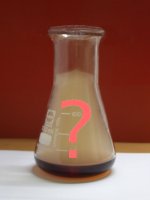

Riddle: Cyanide and nitrogen oxide
This is a simple experiment, where cyanide is made to react with nitrogen oxides and nitrosyl chloride. The cyanide reacts with the gaseous nitrogen compounds, forming a dark brown, water-soluble compound. It is said that this reaction also occurs with nitrogen oxides only, so apparently, cyanide reacts with nitrogen oxides, forming this dark brown compound.
Remarkably, the dark brown compound only is formed with sodium cyanide in the solid form, which reacts with the gaseous product. When under water, then no dark brown compound is formed.
![]()
![]() Required
chemicals:
Required
chemicals:
-
sodium cyanide
- hydrochloric acid
- sodium nitrite
- nitric acid (for alternative experiment)
![]() Required
equipment:
Required
equipment:
-
test tube
![]() Safety:
Safety:
-
 In this experiment
some sodium cyanide is added to a strongly acidic liquid on purpose. Under
these conditions HCN will be formed and certainly some gaseous HCN is
released into the air. This experiment MUST be performed in a properly
working fume hood, or outside. If you are not absolutely sure about the
ventilation or the amount of wind if the experiment is performed outside,
then do not perform this experiment. The compound HCN is a very fast acting
deadly poison and is easily absorbed through the skin. A dose as low as 50
mg, entering the body through any route (e.g. inhalation, through skin), may
be sufficient to kill a grown up person.
In this experiment
some sodium cyanide is added to a strongly acidic liquid on purpose. Under
these conditions HCN will be formed and certainly some gaseous HCN is
released into the air. This experiment MUST be performed in a properly
working fume hood, or outside. If you are not absolutely sure about the
ventilation or the amount of wind if the experiment is performed outside,
then do not perform this experiment. The compound HCN is a very fast acting
deadly poison and is easily absorbed through the skin. A dose as low as 50
mg, entering the body through any route (e.g. inhalation, through skin), may
be sufficient to kill a grown up person. -
 Many
people cannot smell HCN, so the warning properties of this gas can be
considered very poor!
Many
people cannot smell HCN, so the warning properties of this gas can be
considered very poor! -
 This
experiment should not be conducted, when you are alone.
This
experiment should not be conducted, when you are alone. -
 Sodium
cyanide is extremely poisonous. An amount of 250 mg may be sufficient to
kill a grown up person!
Sodium
cyanide is extremely poisonous. An amount of 250 mg may be sufficient to
kill a grown up person! - Hydrochloric acid is corrosive and the concentrated acid gives off corrosive fumes, which are very pungent.
- Concentrated nitric acid is corrosive and destroys the skin on prolonged exposure. Short contact with the acid results in yellow stains.
- Sodium nitrite is toxic and may irritate the skin. In contact with acids, the gases NO and/or NO2 are released.
- In the first stage of the experiment a small amount of nitrogen oxide and/or nitrosyl chloride are released. The amounts are very small, but it is best to have good ventilation. These gasses also are very toxic.
![]() Disposal:
Disposal:
-
Do not flush the cyanide solutions down the drain as is, due to risk of formation of HCN. First destroy the cyanide. This can be done as follows:
-
Take a few grams of sodium hydroxide and dissolve in water. Let liquid cool down.
-
Dilute the solution with the cyanide waste and carefully add the diluted solution the solution of sodium hydroxide.
-
Add quite some concentrated bleach to the solution and let stand for at least a few minutes.
-
-
The destroyed cyanide may be flushed down the drain with a lot of water. Be sure that a lot of water is flushed down the drain, after the cyanide waste is disposed of, just to be sure.
![]()
Formation of liquid, which gives off NOx
Preparation of liquid, which releases NOx (NO, NO2 and NOCl). This can be done by making some aqua regia (mix of 1 part of concentrated HCl and 3 parts of concentrated HNO3 and wait for half an hour, to let the liquid ripen).
An alternative way is to take some hydrochloric acid and add a small amount of sodium nitrite. This causes the gasses NO, NO2 and NOCl to be formed.
At this point, you should have a test tube, with a pale brown/yellow gas mixture above the liquid.
Adding of the sodium cyanide -- formation of dark brown compound
Add some solid sodium cyanide to the test tube, in which the small amount of NOx-gases is present. Add the solid in such a way, that part of it sticks to the glass of the test tube and another part falls into the liquid.
This part of the experiment MUST be conducted in a good fume hood or outside, with sufficient wind from behind. Also, do not take the test tube in your hands in order to be sure that its contents does not by accident touch your skin. The usual household gloves do not provide sufficient protection for this experiment. Use clamps to hold the test tube.
The pieces of sodium cyanide, which stick to the glass and hence are (almost) dry, fairly quickly turn dark brown, almost black. If the concentration of the NOx gases is quite high, then the temperature also rises noticeably at the solid pieces of sodium cyanide.
Here follows a picture of a test tube, in which some aqua regia is present, and some of the dark brown/black solid is present at the glass walls. Further below, a close-up of the dark brown/black stuff is given.
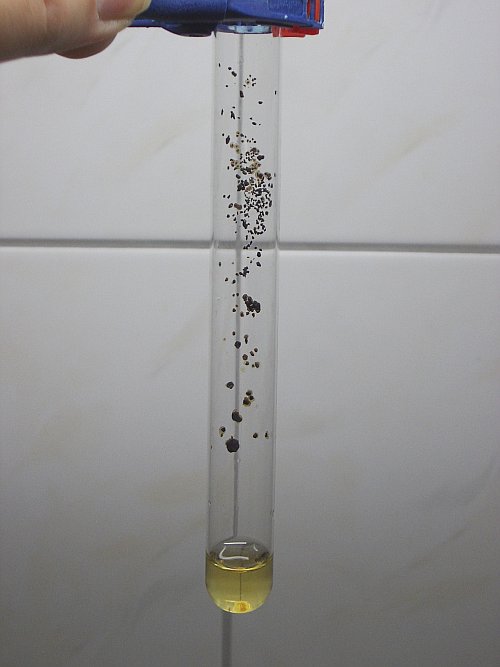
The close-up nicely shows that the really dry pieces become dark brown, while the somewhat wetter pieces remain much lighter. The piece of sodium cyanide in the liquid remains white for a long time, but after several minutes it turns a little brown as well.
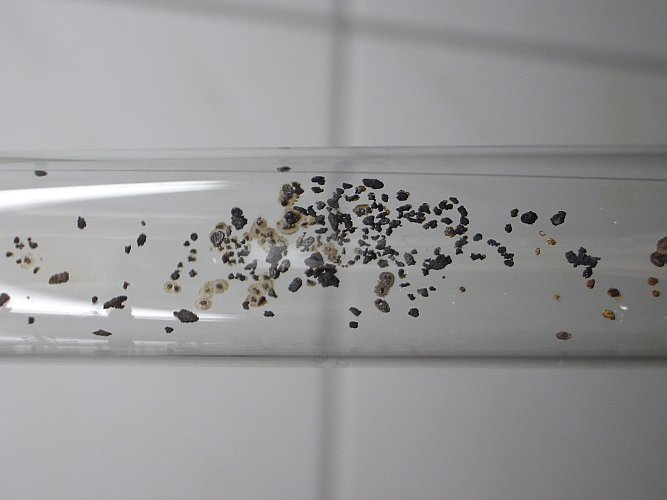
Dissolving the dark compound
When some of the dark compound is scraped off from the glass and added to plain water, then it quickly dissolves and a brown solution is obtained. This solution is fairly dark. When it is diluted, then its color does not change, it only becomes weaker. The picture below shows a diluted solution of the brown compound in plain water.
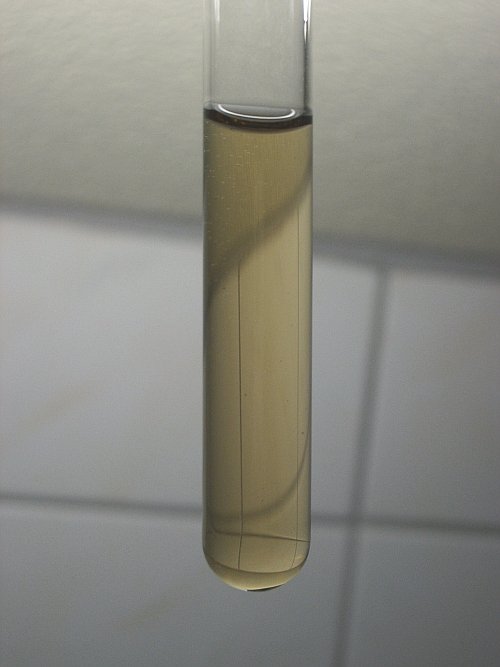
The same compound also is dissolved in aqua regia. The original test tube in which the compound was made, is shaken and the solid dissolved. In the aqua regia of high concentration it hardly dissolves. This can be explained, because the sodium contents of the sodium cyanide makes it almost insoluble in the concentrated aqua regia. When more water is added, then the solid completely dissolves and small bubbles of gas are produced. The larger piece of solid sodium cyanide at the bottom also dissolves completely when more water is added and also small bubbles of gas are produced at that piece of sodium cyanide.
The solution becomes more yellow in the diluted aqua regia. The brown stuff quickly dissolves, but its color differs quite a lot from the color of the solution in plain water. The picture below shows the solution, the formation of small bubbles and the dissolving of the piece of sodium cyanide at the bottom.
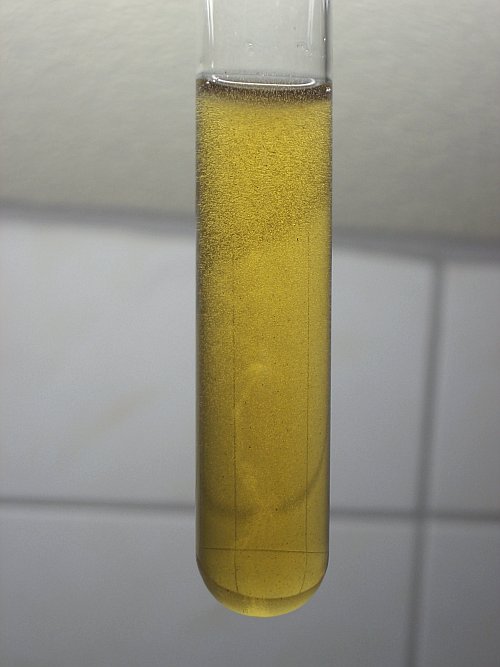
![]()
Discussion of the results
The brown stuff, formed in the reaction between the solid sodium cyanide and the NOx-gases is a mystery to me, the more, because it only occurs in the solid phase. The bubbles of gas, produced on dissolving of the brown material and the sodium cyanide most likely are due to oxidation of the HCN, formed in the liquid, and these probably are a mix of CO2 and N2. The compound HCN is soluble in water very well and almost certainly, these bubbles are not HCN.